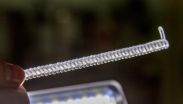(Press-News.org) As climate change is progressing, the temperature of our planet increases. This is particularly important for the large group of animals that are cold-blooded (ectothermic), including insects. Their body temperature is ultimately determined by the ambient temperature, and the same therefore applies to the speed and efficiency of their vital biological processes.
But is it changes in average temperature or frequency of extreme temperature conditions that have the greatest impact on species distribution? This was the questions that a group of Danish and Australian researchers decided to examine in a number of insect species.
Johannes Overgaard, Department of Bioscience, Aarhus University, Denmark, Michael R. Kearney and Ary A. Hoffmann, Melbourne University, Australia, recently published the results of these studies in the journal Global Change Biology. The results demonstrate that it is especially the extreme temperature events that define the distribution of both tropical and temperate species. Thus climate change affects ectotermic animals primarily because more periods of extreme weather are expected in the future.
Fruit flies were modelled
The researchers examined 10 fruit fly species of the genus Drosophila adapted to tropical and temperate regions of Australia. First they examined the temperatures for which the species can sustain growth and reproduction, and then they found the boundaries of tolerance for hot and cold temperatures.
"This is the first time ever where we have been able to compare the effects of extremes and changes in average conditions in a rigorous manner across a group of species", mentions Ary Hoffmann.
Based on this knowledge and knowledge of the present distribution of the 10 species they then examined if distribution was correlated to the temperatures required for growth and reproduction or rather limited by their tolerance to extreme temperature conditions.
"The answer was unambiguous: it is the species' tolerance to very cold or hot days that define their present distribution," says Johannes Overgaard.
It is therefore the extreme weather events, such as heat waves or extremely cold conditions, which costs the insects their life, not an increase in average temperature.
Drastic changes in store
With this information in hand, the researchers could then model how distributions are expected to change if climate change continues for the next 100 years.
Most terrestrial animals experience temperature variation on both daily and seasonal time scale, and they are adapted to these conditions. Thus, for a species to maintain its existence under varying temperature conditions there are two simple conditions that must be met. Firstly, the temperature should occasionally be such that the species can grow and reproduce, and secondly, the temperature must never be so extreme that the population's survival is threatened.
In temperate climate for example, there are many species which are adapted to endure low temperatures in the winter, and then grow and reproduce in the summer. In warmer climates, the challenge may be just the opposite. Here, the species might endure high temperatures during the dry hot summer, while growth and reproduction mainly occurs during the mild and wet winter period.
The result was discouraging for all 10 species.
"Climate change will result in fewer cold days and nights, and thus allow species to move toward higher latitudes. However climate change also leads to a higher incidence to extremely hot days and our model therefore predicts that the distribution of these species will be reduced to less than half their present distribution"says Johannes Overgaard.
"In fact, our predictions are that some species would disappear entirely in the next few decades, even when they have a fairly wide distribution that currently covers hundreds of kilometers", adds Ary Hoffmann.
"Although none of the 10 species studied are normally perceived as either harmful or beneficial organisms for human society, the results indicate that distribution of many insect species will be changed dramatically, and it will probably also apply to many of the species that have particular social or commercial importance ", ends Johannes Overgaard.
INFORMATION:
Contact:
Associate Professor Johannes Overgaard
Department of Bioscience
Aarhus University, Denmark.
E-mail: Johannes.overgaard@biology.au.dk
Telephone: +45 27142634
Professor Ary Hoffmann
Department of Genetics & Department of Zoology
University of Melbourne, Australia
email: ary@unimelb.edu.au
Tel: (03) 8344 2282
Extreme weather decides distribution of insects
Climate change is likely to have profound implications for distributions of insects. Some species may disappear entirely in the next few decades
2014-02-20
ELSE PRESS RELEASES FROM THIS DATE:
UT Dallas-led team makes powerful muscles from fishing line and sewing thread
2014-02-20
An international team led by The University of Texas at Dallas has discovered that ordinary fishing line and sewing thread can be cheaply converted to powerful artificial muscles.
The new muscles can lift a hundred times more weight and generate a hundred times higher mechanical power than the same length and weight of human muscle. Per weight, they can generate 7.1 horsepower per kilogram, about the same mechanical power as a jet engine.
In a paper published Feb. 21 in the journal Science, researchers explain that the powerful muscles are produced by twisting and ...
Bioengineered growth factors lead to better wound healing
2014-02-20
When we are wounded, our bodies naturally begin a process of repair of the damaged tissue. This process is mediated by biological molecules called growth factors, which are proteins that occur naturally in our cells and guide processes ranging from embryonic development to healing. Given their regenerative role in the body, growth factors have been investigated for use in drugs but with limited success. Publishing in Science, an EPFL group has used bioengineering to significantly improve the efficacy of clinical growth factors in the context of soft tissue and bone repair, ...
Previous rapid thinning of Pine Island Glacier sheds light on future Antarctic ice loss
2014-02-20
New research, published this week in Science, suggests that the largest single contributor to global sea level rise, a glacier of the West Antarctic Ice Sheet, may continue thinning for decades to come. Geologists from the UK, USA and Germany found that Pine Island Glacier (PIG), which is rapidly accelerating, thinning and retreating, has thinned rapidly before. The team say their findings demonstrate the potential for current ice loss to continue for several decades yet.
Their findings reveal that 8000 years ago the glacier thinned as fast as it has in recent decades, ...
Scientists create powerful artificial muscle with fishing line
2014-02-20
Researchers are using fibres from fishing line and sewing thread to create inexpensive artificial muscles that could be used in medical devices, humanoid robots, prosthetic limbs, or woven into fabrics.
In a study published today in Science, international researchers, including University of British Columbia Electrical and Computer Engineering professor John Madden and PhD candidate Seyed Mohammad Mirvakili, detail how they created inexpensive artificial muscles that generate far more force and power than human or animal muscles of the same size.
"In terms of the strength ...
Unstable Atlantic deep ocean circulation under future climate conditions
2014-02-20
Today, deep waters formed in the northern North Atlantic fill approximately half of the deep ocean globally. In the process, this impacts on the circum-Atlantic climate, regional sea level, and soak up much of the excess atmospheric carbon dioxide from industrialisation — helping to moderate the effects of global warming. Changes in this circulation mode are considered a potential tipping point in future climate change that could have widespread and long-lasting impacts including on regional sea level, the intensity and pacing of Sahel droughts, and the pattern and rate ...
Sequencing hundreds of nuclear genes in the sunflower family now possible
2014-02-20
Advances in DNA sequencing technologies have enormous potential for the plant sciences. With genome-scale data sets obtained from these new technologies, researchers are able to greatly improve our understanding of evolutionary relationships, which are key to applications including plant breeding and physiology.
Studies of evolutionary (or phylogenetic) relationships among different plant species have traditionally relied on analyses of a limited number of genes, mostly from the chloroplast genome. Such studies often fail to fully or accurately resolve phylogenetic ...
Study shows that premature infants benefit from adult talk
2014-02-20
Research led by a team at Women & Infants Hospital of Rhode Island and The Warren Alpert Medical School of Brown University has been published in the February 10, 2014 online edition of Pediatrics, the official journal of the American Academy of Pediatrics. The research indicates that premature babies benefit from being exposed to adult talk as early as possible.
The research, entitled "Adult Talk in the NICU (neonatal intensive care unit) with Preterm Infants and Developmental Outcomes," was led by Betty Vohr, MD, director of Women & Infants' Neonatal Follow-Up Program ...
GW researcher finds gene therapy a promising tool for cardiac regeneration
2014-02-20
WASHINGTON (Feb. 20, 2014) — After a heart attack, there is often permanent damage to a portion of the heart. This happens, in part, because cardiac muscle cells are terminally differentiated and cannot proliferate after blood flow is blocked off to the heart. This partial healing can be attributed to heart disease being one of the leading causes of death. What if the cells could be stimulated to divide and the heart could be induced to repair itself? This was the question posed by George Washington University (GW) researcher Scott Shapiro, M.D., Ph.D., and his co-authors, ...
Active thyroid may raise risk of depression in older individuals
2014-02-20
Chevy Chase, MD—When older individuals' thyroid glands are more active than average, it may be a risk factor for depression, according to new research accepted for publication in the Endocrine Society's Journal of Clinical Endocrinology & Metabolism (JCEM).
Beyond its role in regulating the body's metabolism, the thyroid gland also can influence mental health. Past research has found links between an increased risk of depression and both over- and underactive thyroid glands. This study is the first to find an association between depression and thyroid activity variations ...
Stress hormone linked to frailty
2014-02-20
Chevy Chase, MD—Lower morning and higher evening cortisol levels contribute to frailty in older individuals, according to new research accepted for publication in the Endocrine Society's Journal of Clinical Endocrinology & Metabolism (JCEM).
Frailty confers a high risk for institutionalization and increased risk of mortality and is characterized by unintentional weight loss, feelings of exhaustion and fatigue, physical inactivity, slow gait speed and low grip strength. Neuroendocrine function, including cortisol secretion, is thought to be involved in the etiology of ...
LAST 30 PRESS RELEASES:
Injectable breast ‘implant’ offers alternative to traditional surgeries
Neuroscientists devise formulas to measure multilingualism
New prostate cancer trial seeks to reduce toxicity without sacrificing efficacy
Geometry shapes life
A CRISPR screen reveals many previously unrecognized genes required for brain development and a new neurodevelopmental disorder
Hot flush treatment has anti-breast cancer activity, study finds
Securing AI systems against growing cybersecurity threats
Longest observation of an active solar region
Why nail-biting, procrastination and other self-sabotaging behaviors are rooted in survival instincts
Regional variations in mechanical properties of porcine leptomeninges
Artificial empathy in therapy and healthcare: advancements in interpersonal interaction technologies
Why some brains switch gears more efficiently than others
UVA’s Jundong Li wins ICDM’S 2025 Tao Li Award for data mining, machine learning
UVA’s low-power, high-performance computer power player Mircea Stan earns National Academy of Inventors fellowship
Not playing by the rules: USU researcher explores filamentous algae dynamics in rivers
Do our body clocks influence our risk of dementia?
Anthropologists offer new evidence of bipedalism in long-debated fossil discovery
Safer receipt paper from wood
Dosage-sensitive genes suggest no whole-genome duplications in ancestral angiosperm
First ancient human herpesvirus genomes document their deep history with humans
Why Some Bacteria Survive Antibiotics and How to Stop Them - New study reveals that bacteria can survive antibiotic treatment through two fundamentally different “shutdown modes”
UCLA study links scar healing to dangerous placenta condition
CHANGE-seq-BE finds off-target changes in the genome from base editors
The Journal of Nuclear Medicine Ahead-of-Print Tip Sheet: January 2, 2026
Delayed or absent first dose of measles, mumps, and rubella vaccination
Trends in US preterm birth rates by household income and race and ethnicity
Study identifies potential biomarker linked to progression and brain inflammation in multiple sclerosis
Many mothers in Norway do not show up for postnatal check-ups
Researchers want to find out why quick clay is so unstable
Superradiant spins show teamwork at the quantum scale
[Press-News.org] Extreme weather decides distribution of insectsClimate change is likely to have profound implications for distributions of insects. Some species may disappear entirely in the next few decades



